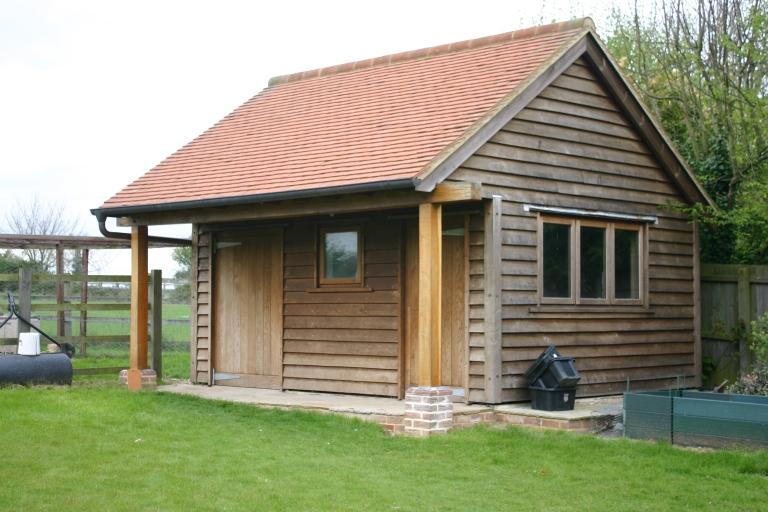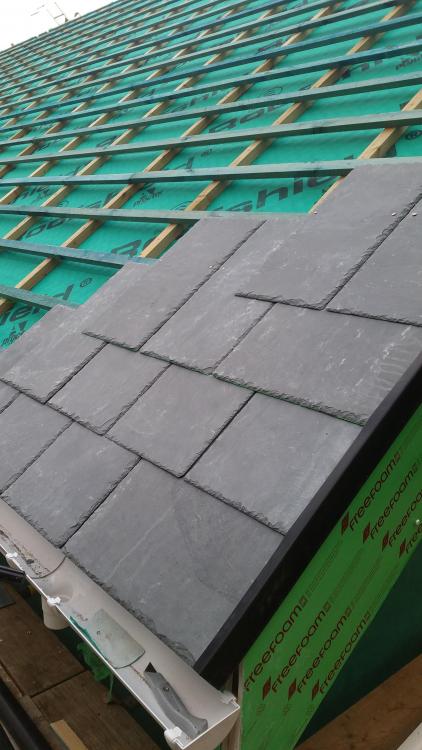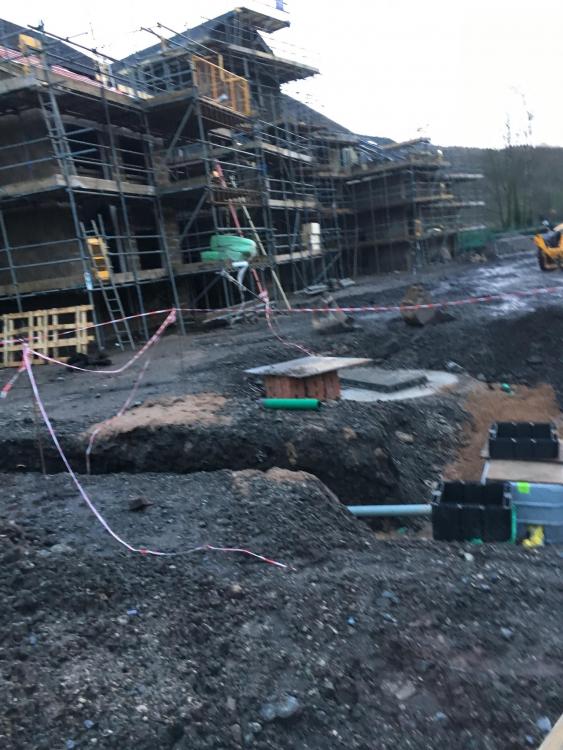Leaderboard
Popular Content
Showing content with the highest reputation on 09/09/20 in all areas
-
Hello, It’s been around two months since we moved in. After a brief period of enjoying the summer and the new house we have made a push towards getting our completion certificate. We got our air test which came back as 3.33. We got the property registered for Council tax, pleased the assessor rated the property as a band D. The last bit of major building work has been the construction of the ramp and decking. We always knew that because of the ground conditions and the suspended timber floor our ramp was going to be higher than your average. After considering many different options we decided to build one out of Siberian Larch, which allowed us to have just a single order and the joiners could do the two together. I’ll need to apply some non-slip oil in the next few weeks. Here is one of the ramp And the decking. As with many self builders I now have an abundance of wooden pallets. I broke a few of them up and started on this. It’s a wood store. Still some finishing touches required. What’s next, all being well, hopefully a final inspection and completion. Other jobs which won’t hold this up, but on the to do list are proper downpipes and ordering gravel for around the house.5 points
-
He’s talking rubbish http://www.greengenuk.com/mitsubishi-ecodan-installation-11-2kw-heat-pump-polperro/ Perfectly acceptable and what he hasn’t done is RTFM.... Basically this is a straight wiring job, the FTC5 controller has a boost setting. They wire the Eddi/iBoost NV switch to the correct terminals as per the installation guide.3 points
-
A friend of mine bought an estate house with similar fencing back from ownership of land, he was told he could move the fence and heard on the grapevine the builders do it to make the estate look better (wider roads and verges).3 points
-
From what I can gather it is Alto energy who seem to have caused a lot of the confusion but I would have expected the plumber to have known what I was told in this thread. In fairness to our electrician who just happened to be on site as we're meeting on another matter, he picked up on part of the conversation and seemed to know exactly what I was on about and spoke to the plumber.2 points
-
We are not Passive House Traditional Build Very well insulated UFH 18 months since moving in We have never used the first floor radiators Or the three very expensive towel rails in each bathroom2 points
-
I think what i might do is run a fused spur in there as a power source but wait and see how it works.2 points
-
Is it possible that the collective wisdom of the forum has not considered one possibility namely that full time professional planners are competent ? I have a suspicion that the objection from git at the back was dismissed by the planners and one of the "nice" near neighbours is lying and was the source of the credible objection.2 points
-
2 points
-
Problem solved. I made a few shim strips out of a roofing batten using a table saw and inserted them on the fascia, under the felt trays and vents. It all screwed back together nicely. I will probably use the thinnest neoprene foam strip I can find on the vents - say 2-3mm - to give the slates something to bed on. The boss is very keen to not have a roof with rattles!1 point
-
Plus if the 2 of 3 course pour your proposing doesn’t equate to a full load you will get a part load charge which can be £50+ for every cube not carried.1 point
-
I am not a plasterer but can plaster and this is atrocious work. ( there are plasterers on this forum who will give their professional opinion). Not sure what you can do about it now as skimming again is a lot of work/expense depending on who is going to do it as I would not use the plaster you have used again. Easifill is great for going over slight blemishes but again is a lot of work. Hope you can get it sorted.1 point
-
Pretty squeamish about squashed animals on the roads. You know the ones you notice that slowly disintegrate each day when you pass. Worse than that is when I'm driving and there is like a million frogs and toads hoping across the road. It's total carnage.1 point
-
I cannot see any logical reason for wanting to do more pours than you need to, my first pour was at 2.7 then the next was at finished height, I used lots of starter bars placed in the first pour 600mm apart, I also put vertical bars at all door and window reveals. If a concrete pump is going to cost you £600 you will waste a lot of money messing about doing little pours. As for the digger bucket idea, just forget that right now, do it right use the proper kit and do it like a professional would, hire a pump job done.1 point
-
I've been back over this thread and its intensely frustrating because so many posts are unclear. Earlier ProDave asked.... and you replied.. However you didn't say if those were the reasons given by the neighbour or by the planning officer? Then you said.. Can you cut to the chase and just post a scan of the formal decision letter (blank out the address and planning reference if you like).1 point
-
Temp, I'm not having a dig, but the title plans from the land registry are of little value. They can't be scaled from, and they show only general boundaries. The land registry clearly state that. Trees and buildings can't be used. Trees change shape, and grow, and any building, or buildings have to have been there when the site plan attached to the conveyance was drawn up. .Anything that is not either discribed on the conveyance, or on the site plan attached to the conveyance can't be used. The neighbour, can still claim adverse possession rights under the old rules, that were changed in 1990 i believe. He has no need to use the new rules. If anybody wants to make a claim for a piece of land, that is not in there exclusive use, they are in for a rough ride. Even if the poster had an original site plan, that had clear points of origin, that could be used by an expert, and ascertained that the land was part of his original deeds. If he has been excluded from that land by means of a fence, etc, for a period of time. He would be very unlikely to ever get it back, unless he had a very, very nice neighbour. To be honest, people like the poster get right up my nose. He bought a house, and got what he paid for. He got exactly what he expected to buy at whatever price he paid. He for whatever reason, (found an old plan, etc) now thinks he may own a piece of land that is in somebody else's posession. That extra piece of land may have indeed been part of the original conveyance, but it's long gone. When he purchased he got what he expected to get. Land up to the fence.....1 point
-
I'd think about blown LECA (can be blown tens of metres), which will be less penetrable by Roland and his friends. It has been used to entirely fill underfloor voids in renos as an alternative to polybeads. Insulation values will be poorer, but it is still an insulator. It may be an alternative solution to just open a few small (ish) holes in the floor and put in through those. Also not sure about current prices, but give the circmstances it may be what you need.1 point
-
Years ago I recall reading about someone that put expanding foam in the metal mast of a yacht. He did it by lowering a plastic pipe into the mast and pouring mixed two part foam down the pipe using a funnel. Someone else gradually pulled out the pipe as the foam went in. I would suggest doing a practice run outdoors somewhere to get the flow rate and pipe removal rate right. I tried putting expanding foam into a stud wall once. It didn't end well. The side I was working looked fine. Later discovered the other side was pregnant.1 point
-
If you have what you thought you were buying, then 98 times out of 100 it is unlikely to be worth the collateral damage / aggro (imo). I have been on Gardenlaw, which specialises in this type of debate, since (checks) 2005. It is interesting that over that period the general view has changed from the "war of attrition" end towards the "live and let live" end. In general that is my view, with a few exceptions. Perhaps plant a hedge your side and let nature have the strip in between if it is not an existential issue. Then enjoy your new house. F1 point
-
150mm hollowcore slabs, 25mm insulation boards, UFH clipped to boards, 50mm liquid screed. I've a service void coming up the middle of the building. so the two loops (one for wetrooms, one for bedroom). Manifold etc will be in the basement. 5KW ASHP via a buffer tank. It's a passive house so the loops will be minimal. I'm only planning on three zones - basement, master bedroom (first floor) and all other areas (main living area on ground floor)1 point
-
This maybe an overzealous interpretation of Part L https://www.intergasheating.co.uk/app/uploads/2018/06/Guidance-on-Boiler-Plus-BEIS.pdf That states every house must have 2 independent temp controlled zones, and the guidance is these are often "living area" (downstairs) and "sleeping areas" (i.e. upstairs) FWIW we had a lot of conflicting advice on if we needed upstairs heating or not (and we are going PH certified, all be it EnerPHit). So we comprimsed on putting fused spurs into each bedroom to allow a possible future infrared panel heater if needed, and plumbing into the loft to allow a possible future fancoil unit if needed1 point
-
This is our UFH downstairs, but that is a suspended timber floor so no different to doing the same upstairs. that's OSB over the joists (just to support the biscuit mix) Battens following the joist lines. Buiscuit mix screed between the battens Then Oak engineered flooring went over the top. Insulation was between the joists. An alternative is to use aluminium spreader plates.1 point
-
My sincere apologies. I did not intend sarcasm. I try hard not offend, but in this case, not hard enough it seems. Our recent visit by thieves has made me a little raw.1 point
-
Another in Scotland just north of Inverness. No heating upstairs other than UFH in the bathrooms. Been through 2 winters without needing heating in the bedrooms. I did install cables to heater points in each bedroom so we could fit a small panel heater, but unused and cable not connected at either end yet.1 point
-
I’m not in Scotland but I have no heating upstairs (apart from towel rads in bathrooms) and it was not questioned. I followed passive fundamentals but not qualified or certificated.1 point
-
We're in Scotland, just West of Inverness. We don't have any heat sources upstairs with the exception of a towel rail in the bathroom although it's only 40w or something like that. I wasn't aware of any rule about needing to have a heat source in every room. I have had the bedrooms wired in case we find we need upstairs heaters but no plans to fit them unless we think they're really needed. In saying all this, we don't yet have our completion certificate, so may still be pulled up on something. I don't think there are special rules for passive houses in this regards, the only possibility might be if your SAP suggests you might need a high heat input which can't be delivered with the number of heaters you propose? I think there are a few folk on here in Scotland who don't have much heating upstairs, so I might be tempted to question the source of your Architects information.1 point
-
For me personally , having solar and a well insulated house/air tight was always about the climate impact, as I can't see any of the cost involved in doing all that work would be paid back financially and wasn't really a consideration.1 point
-
Literally just had a call from the plumber. The penny has finally dropped! I've sent all the information summarised in this thread hopefully he realises what a plank he has been!1 point
-
Now you're seriously pushing it ? although I do think we don't have the full picture on what the formal reasons for refusal were1 point
-
Also, take a look at all the current Garden Communities (Garden Villages) being designed at the moment. The larger open plan, open spaces are part of what attracts buyers.1 point
-
This is true... I have been involved in a few site developments and the fence boundaries are quite often defined by the overall aesthetics of the development rather than optimised for a home owner or any other practical reasoning. .. the extra few metres of garden are unlikely to add as much value (to the developer) as an open community space. Can you imagine what it would be like if all estate properties had fences up to their boundaries... it would be like entering a maze.1 point
-
A householder minor planning application is very cheap in my part of the world and would help clarify matters. A thumbs up from the planners would not legally trump the legal constraints in your deeds so you will a solid thumbs up from your solicitor. Do school children walk past your property?1 point
-
When I asked a similar question the Planning Office responded saying "we would not object in principle though we would defer to the opinion of highways".1 point
-
hard to tell exactly but the fence might have been placed that far back off the road to allow for visibility splays and/or for services to run along side the road1 point
-
It looks like you’re house is part of a fairly modern estate perhaps 20-30 years old? . Which makes me wonder why the developer wouldn’t have had the fencing placed at the edge of your boundary from the outset, so they could sell a house with a bigger garden. There must be a reason for them not doing so and that reason may be Perhaps visibility at the junction something like that ?1 point
-
I can't believe this has rumbled on for three pages! either we aren't getting the full story as to what the planning officer has said in their reasons for refusal or the op should just get a planning application submitted and ignore what non-planning policy related objections the neighbour has1 point
-
Personally I would not give them a penny, spend the money on a formal application. The neighbour consultation scheme, also known as prior notification requires a 21day period where the neighbours of the property in question have the right to object with valid reasoning as to why the extension must not be built. After this the local authority have a further 21 days to issue the go ahead. just found this, three words spring out. WITH VALID REASONING. your neighbours objections are not valid under planning policy and the planners saying if anyone objects they must refuse is plainly wrong (and lazy).1 point
-
That was my initial thought, but if you're extracting from there, the heat will be sucked straight out unless you run it constantly. Perhaps just try with the mvhr for a start, that should be plenty good enough for 'airing'.1 point
-
Thicker vent strip? But the real answer is raise the fascia a bit.1 point
-
Another possible piece of your toolkit is one of those dehumidifiers with a heating element.1 point
-
If he called the police by the time they show up the delivery vehicle will be gone, they will look a bit silly.1 point
-
Just on this you will need to plan for how you would remove the liner to replace it in future. That requires access to both ends of the flexible liner, and it looks like you will only have access to the top..? I think you may need to remove a couple of joints before continuing, potentially replace the 6” through the wall with 8” and route the liner through this.1 point
-
I should have done an IRR calculation, the longer you own the panels the less the initial cost matters. If the total cost of the panels was £4000 and you saved £300 a year in electricity then the IRR would be 5.7% over 25 years if you assumed that the system was worthless at that point, in reality it will still be generating electricity and making a return. I have previously looked into the requirement to replace inverters. As far as I understand this is exaggerated and they may well last considerably longer, 10-20 years or even more for microinverters. If you want to assume that the inverter is replaced half way through the 25 years then the return would drop to 4.9%. If you assume that the price of electricity rises by 2% a year then the return rises from 5.7% to 7.7%. If you offset this by degrading the panels by 10% over 25 years then the return would be 7.2%. These numbers are based on using 2300kWh a year from the array. If you got 3000kWh then the returns would be considerably higher, 7.2% would increase to 10.4% for example. This is probably closer to the output you would expect but you might not use it all. The yield to maturity on a 25 year UK government bond currently is 0.7% for comparison. The yield on 5 year bonds is negative! The yield on a 25 year inflation linked bond is -2.3%. This includes the benefit of getting your money back at the end of the period and so is calculated in the same way. Another way to look at it is what mortgage payment could the income cover. £400 a year would cover the payment on £7000 of 25 year repayment mortgage at 3%. You can put in other numbers if you like, but the point is that relative to other low risk investments or to the cost of a mortgage this would be a very good return at today's interest rates. Where solar panels get weird is that despite the nice cash return they make it is difficult to get anyone to pay you for them when you sell your house, so these calculations make sense if you plan to live in your house for 20+ years, but not if you end up selling it and not getting paid for the panels.1 point
-
I'm siting my airing cupboard above an ufh manifold, I think that will have some losses, combined with mvhr extract above to draw the air through.1 point
-
I would just get on with it. If he tries to get his car out tell him you will move as soon as possible and do so. If he calls the police and they turn up (which I doubt) be exceptionally polite to the police and make sure they see you are rushing about trying to unload quickly. Apologise for them having to come out. Let the neighbour rant and rave. The police will soon understand who has the problem.1 point
-
I disagree - revenge best served cold. Go get formal planning permission and build what you are legally entitled to.1 point
-
Ask the neighbour what their price is to remove the objection. Most people will have a £ price that will change their mind.1 point
-
The dry dash is where the stones are hurled onto a top coat dry Wet dash is similar but the stones are mixed in with the cement and hurled on in a runny concrete type mix In the Lake District we are usually asked to either use white cement and silver sand with limestone clippings to give an off white finish or granite chippings to give a blueish green finish Most of the modern houses use a k dash Lots of colours Can be sprayed on not great pictures but this is one we finished over lockdown Left natural colour1 point
-
Good evening Miri Piri. Looking at water supply and septic tank/ perhaps something that treates the sewage to a higher level such as a some form of treatment plant, more costly but can offset the cost of a soak away type drainage field. Broadly speaking, to get you a feel for things, you often see information presented in tems of bedrock and superficial deposits, in some ways it's much easier in Scotland as you don't have to deal with sink holes that can occur in limestone, deep clay, complex ground conditions and soil layers that you get down South. There is some tricky ground in the Forth valley / Glasgow and so on for example. Also, you don't have to deal with mining that occurs in the Central belt. I think you Mum talks sense. A superficial deposit is the soil that generally sits on top of the bedrock. The term soil is used by Engineers to often describe the stuff you build on rather than the "top soil" on which the grass grows. Roughly, Tonalite is a form of granite. The UK was not always one land mass. Essentially it was originally part of two ancient land masses that came together. Once they came together there have been a number of different ice ages, which have eroded the land, melted and dumped stuff where the ice melts, this is often called "till". It can be fine minerals, small pebbles, boulders the size of houses, more and anything else that the glacier picked up on it's way. The Late Devension age is split up a bit but roughly the last period (say 22 -33 thousand years ago) relates much to the last major ice age although there was a more recent one on the west cost, around Loch Lomand. So this descibes when the till was laid down. Diamiction often describes how this stuff (till) was then moved about, further mixed up and redeposited. In other words you could have a good mix of material, some more suited to water extraction / sewage soak away. You mention that you are on a slope and that water comes into your mum's garage. But you have a field above so that surface water may not be suitable as a potable water supply. The key here may be to tap in above the house to the ground water that lies deeper and this could give you a good reliable supply. If you are interested then to do this you want to look for the fractured / weathered rock and there could be a decent layer of this not too far down. The best way is to dig a few good sized holes with a jcb first. Dig through the top layer of soil until you hit the rock, clean it off and have a look at it. If it looks like it has fractures of a good width or lots of small fractures (you probably won't see gaps just bands of the till that have washed into the gaps in the rock) in it then it's worth exploring more. If you don't fancy that then call a few of the bore hole companies and they will give you some good pointers. As the surface ground water is high and you have a sloping site you will probably struggle to get a soak away to work at a sensible cost if at all. From what you describe it seems like the top layers of soil that could be used for a soak way are thin and not very permeable. For the sewage you may be able to use a treatment plant and run a small discharge pipe to the burn? Lastly before you spend any money give SEPA a call or drop them an email to check if there are any restrictions on a private water supply with regards to radon.1 point
-
Are all the traps full of water? We have to remember to run the tap in the bath in the second bathroom once a month or so (we don't use it) otherwise the MVHR extract in there pulls in smells from the treatment plant when the trap dries out.1 point
-
I agree with Dave Poor No sanding I skimmed five bedrooms last week There will be no ripples or filling To many are one coating and running over the skim with plastic float or spatula1 point

















